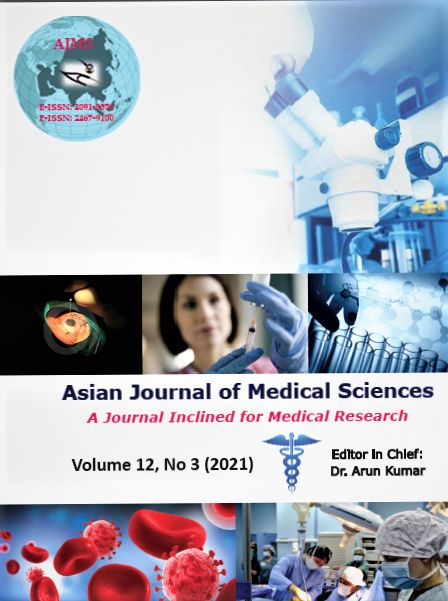Slit Lamp profile of Pseudoexfoliation eyes
Keywords:
Pseudoexfoliation, pupillary dilatation, slit lampAbstract
Background: Pseudoexfoliation syndrome is an age-related systemic microfibrillopathy, caused by progressive accumulation and gradual deposition of extracellular grey and white material over various tissues. It is associated with many intraocular abnormalities like poor pupillary dilatation, zonular dehiscence, glaucoma etc. Hence it is important to do detailed slit lamp examination with dilated pupil to detect the pseudoexfoliative deposits in eye, especially in elderly to prevent unforeseen complications.
Aims and Objective: To study pattern of distribution of pseudoexfoliative material in eyes with pseudoexfoliation syndrome and to study the dilatation profile of pupil in such eyes.
Materials and Methods: This observational study was conducted on patients with pseudoexfoliation syndrome who attended OPD in the Upgraded Department of Ophthalmology, Government Medical College, Jammu from 1st April 2018 for a period of 6 months. The clearance was taken from ethical committee for the study in reference. Informed consent was taken from all the patients enrolled in the study.
Results: Pupillary margin was found to be the most common site for deposition of pex material i.e. 51 (75%) patients followed by anterior surface of lens in 32(47.05%) patients. Patients had simultaneous deposition of pex material over various parts of the eye. 64 (94.12%) patients had pex material deposited on pupil or lens. Only 1(1.47%) patient had pex deposits over cornea. 56 (82.35%) patients attained good to moderate dilatation of pupil with 0.8% tropicamide e/d. 12(17.65%) patients had pupillary dilatation of ≤4mm hence poor dilatation.
Conclusion: Pseudoexfoliation presents challenges that must be adequately addressed with detailed slit lamp examination. Cases may go undetected due to failure to dilate the pupil or to examine with slit lamp after dilatation. Adequate pre-operative assessment should especially be done before cataract surgery with the aim to identify problems like the possibility of fragile zonules and inadequate mydriasis which could increase intraoperative complications arising from undue manipulations.
Downloads
Downloads
Published
How to Cite
Issue
Section
License
Authors who publish with this journal agree to the following terms:
- The journal holds copyright and publishes the work under a Creative Commons CC-BY-NC license that permits use, distribution and reprduction in any medium, provided the original work is properly cited and is not used for commercial purposes. The journal should be recognised as the original publisher of this work.
- Authors are able to enter into separate, additional contractual arrangements for the non-exclusive distribution of the journal's published version of the work (e.g., post it to an institutional repository or publish it in a book), with an acknowledgement of its initial publication in this journal.
- Authors are permitted and encouraged to post their work online (e.g., in institutional repositories or on their website) prior to and during the submission process, as it can lead to productive exchanges, as well as earlier and greater citation of published work (See The Effect of Open Access).




